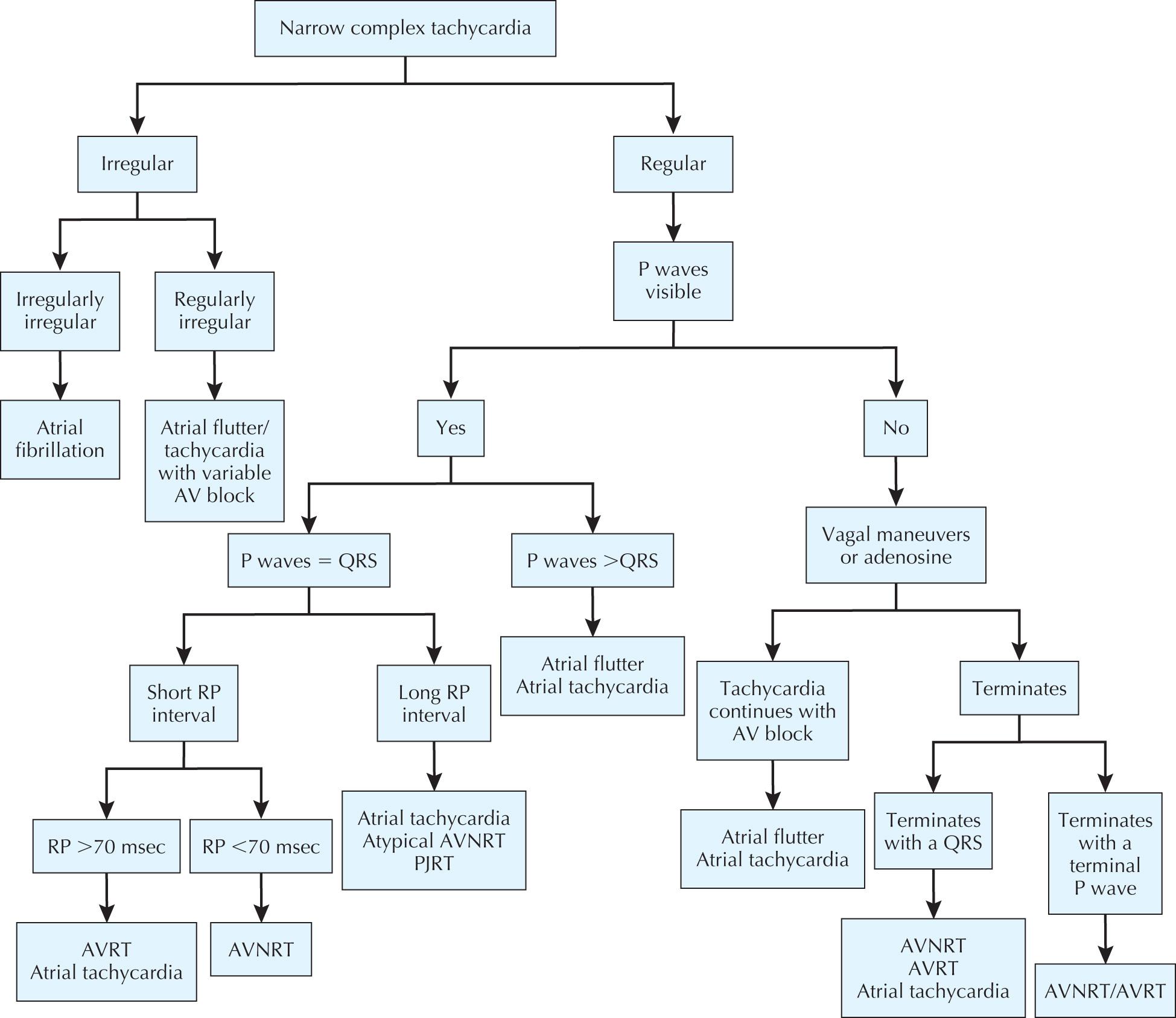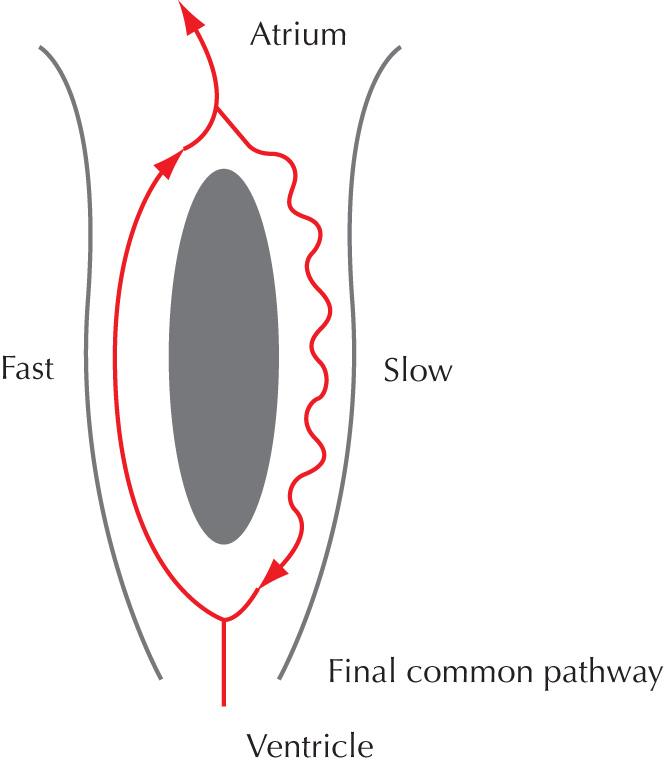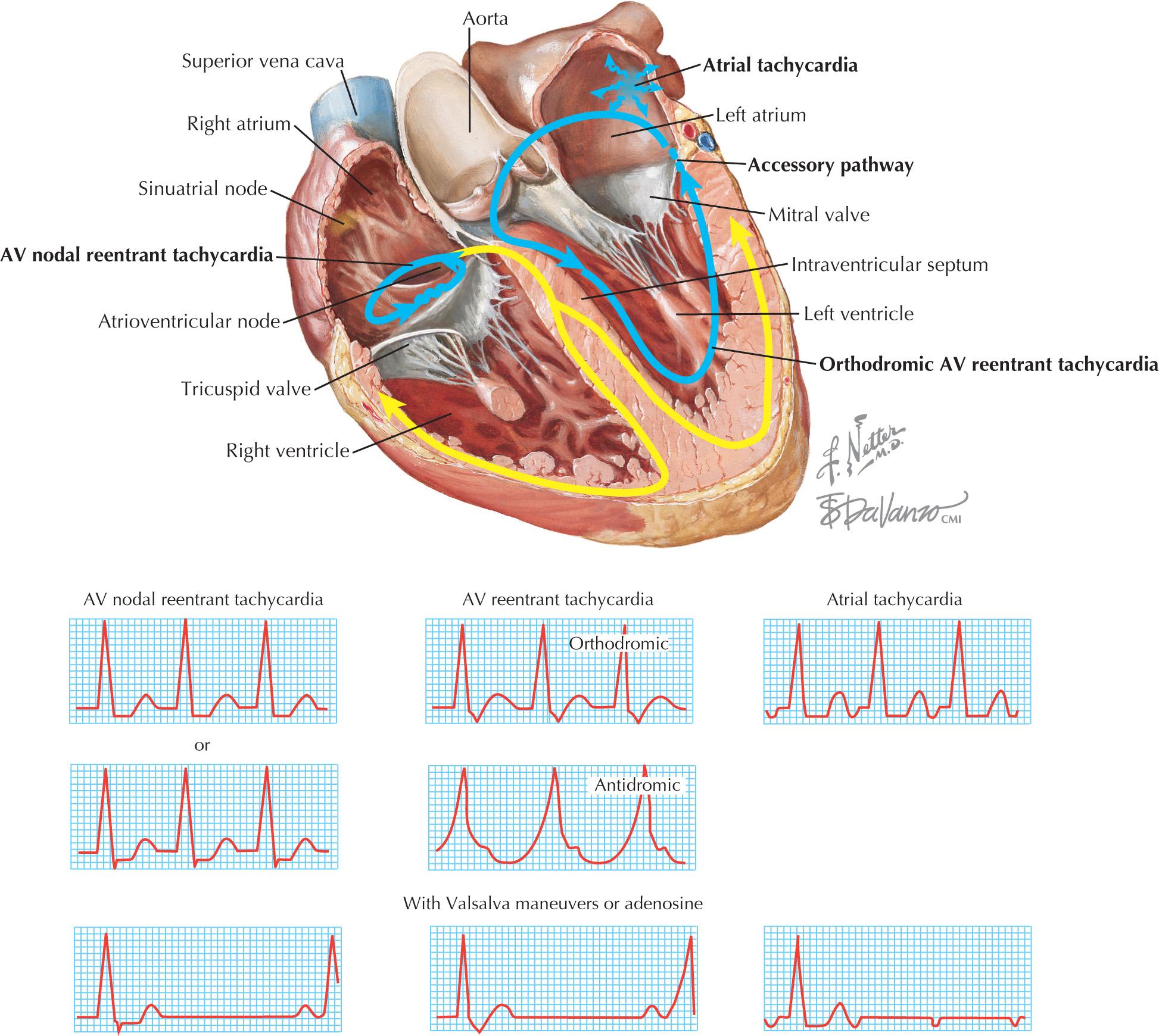Physical Address
304 North Cardinal St.
Dorchester Center, MA 02124
Supraventricular tachycardia (SVT) is an abnormally rapid heart rhythm originating proximal to the bifurcation of the bundle of His. SVTs are relatively common clinical arrhythmias that present in people of all age groups. They are frequently symptomatic and often result in the patient seeking medical attention on an emergent or nonemergent basis. Vagal maneuvers may be useful to terminate SVTs that are atrioventricular (AV) node–dependent. In >80% of cases, a good history and a careful examination of the ECG allow for the diagnosis. Treatment decisions for SVT are usually based on whether the patient is stable or unstable when they present with the tachycardia. In most cases with SVT, patients are usually stable, and a nonemergent approach may be taken. Treatment often includes medications, catheter ablation procedures, or in some cases, surgery. Classification of SVTs are usually based on the site of origin, the nature of the arrhythmia, or the mechanism. In this chapter, we discuss classification, recognition, and treatment of the most common form of SVTs. Atrial flutter (AFl) and atrial fibrillation (AF), although both are forms of SVT, will be covered in a separate chapter.
Categorization of SVTs may be based on the site of origin, their mechanism, or their appearance on surface ECGs. Sites of origin include the sinus node, the atrium, the AV node, and the proximal His bundle. Some wide complex tachycardias are also supraventricular in origin and recognizing and differentiating them from ventricular tachycardias (VTs) are important. Fig. 37.1 details a stepwise algorithm to approaching a tachycardia based on the surface ECG appearance and response to clinical maneuvers.

Reentry is the most common mechanism of SVTs. Reentry requires two roughly parallel conducting pathways, shown as pathways A and B in Fig. 37.2 , that must be connected proximally and distally by conducting tissue, thus forming a potential electrical circuit. Second, one of the pathways (pathway B in our example) must have a refractory period that is substantially longer than the refractory period of the other pathway. Third, the pathway with the shorter refractory period (pathway A) must conduct electrical impulses more slowly than the other pathway. If all these seemingly implausible prerequisites are met, reentry can be initiated when an appropriately timed premature impulse is introduced to the circuit. The premature impulse must enter the circuit at a time when pathway B (the one with the long refractory period) is still refractory from the previous depolarization and at a time when pathway A (the one with the shorter refractory period) has already recovered and is able to accept the premature impulse.

The other main mechanism is abnormal automaticity of tissue that may arise in any of the previously described sites for SVTs. Tachycardias due to abnormal automaticity may be unifocal or multifocal. The least common mechanism of tachycardia is triggered reentry.
Most SVTs present with palpitations as a common sign; however, more ominous presentations such as shortness of breath, obtunded consciousness, chest discomfort, or severe chest pain may also be presenting signs. Sudden cardiac death (SCD) is an extremely rare form of presentation and occurs in <0.3% of patients per year. SCD occurs almost exclusively in patients with Wolf-Parkinson-White (WPW) syndrome with rapid AF that degenerates to ventricular fibrillation (VF).
Abrupt onset and termination suggests a pathological tachycardia, and the response to vagal maneuvers indicates that the AV node may be an integral part of the circuit, such as AV reentrant tachycardia (AVRT) or AV nodal reentrant tachycardia (AVNRT). Statistically, these account for >90% of SVTs. However, abrupt termination with vagal maneuvers may also be seen more uncommonly in focal atrial tachycardia (FAT) and some types of VTs. A described irregularity could predict AF, AFl, or AT with variable block, although the awareness of regularity versus irregularity may vary widely.
Palpitations in patients with SVT are usually characterized by sudden onset and termination, which are hallmarks in differentiating them from sinus tachycardia. Episodes may last for seconds or minutes, but in rare cases, episodes can last several hours and sometimes for days. The frequency is also variable, and although some patients may present with several episodes per day, the usual presentation is more commonly a few a year. The frequency and duration of episodes, and severity of symptoms often help guide how aggressively a provider must pursue a diagnosis or treatment plan. However, patients may be instructed in how to count their pulse rate manually, and there are currently numerous smart phone applications that can reliably record a heart rate.
SVTs are usually triggered by ectopic beats in most people. Substances like asthma medications, cold supplements, herbal remedies, and dietary supplements, especially those containing sympathomimetic compounds, alcohol, caffeine, or tobacco may predispose people to increased ectopy and trigger an episode of SVT. Tiredness, emotional upheavals, or stress can also lead to an adrenergic surge, precipitating SVT.
A medical history such as hyperthyroidism or catecholamine-producing tumors may predispose patients to episodic palpitations.
Examination is an important and essential tool because it can differentiate the patient who needs an emergent treatment from one who does not.
A physical examination should include the general appearance of the patient, heart rate, blood pressure, and jugular venous pressure (JVP). Physical maneuvers, using methods such as ice to the face, a carotid sinus massage, Valsalva, or coughing may be both diagnostic and therapeutic if the AV node is an integral part of the circuit, as described earlier. A slowing of the tachycardia with a vagal maneuver can uncover 1:1 AV conduction or help a bundle branch aberrancy recover and change a wide complex tachycardia to a narrow complex tachycardia. Presence of a murmur, displaced apical impulse, or a gallop can portend associated heart disease.
The ECG is the principal tool in diagnosis, especially during tachycardia. Many patients with SVTs may have normal resting ECGs, and longer term ECG monitoring may require a continuous ambulatory recorder, such as a 24-hour to 14-day Holter monitor. Event monitors may be useful in patients with infrequent symptoms. There are two types of event recording devices, one that has a capability of recording only when activated, and a second type, which is a looping recorder that continuously records the rhythm in addition to tracing several minutes before the recording and tracking the activation. Upper and lower rate parameters can also be programmed to record automatically on these devices. Again, these monitors are only useful if symptoms occur while the monitor is being worn; implantable loop recorders may be considered in patients with infrequent symptoms. These are especially useful for determining the presence or absence of an arrhythmia during symptoms of syncope or palpitations when conventional testing has proven inconclusive.
Other ambulatory tests such as an exercise stress to diagnose arrhythmias that occur during increased catecholamine surges may be useful.
Finally, an invasive electrophysiology (EP) study in which intracardiac catheters are used to record activity from several regions of the heart is useful for a definitive diagnosis and permanent treatment.
Most narrow complex tachycardias (QRS <120 ms) are SVTs, and wide complex tachycardias (QRS >120 ms) are VTs with some overlap ( Box 37.1 ). Regardless of the QRS width, noting the P waves and the relationship of the P waves to the QRS is extremely helpful. More P waves than QRS complexes suggest a tachycardia of atrial origin. When there is a 1:1 relationship between the two, it is important to determine if the rates are identical and if not, if there is a predictable relationship between the PP and RR intervals. The P-wave axis is useful in determining the origin of atrial activation. One method for subdividing a narrow complex tachycardia is to examine the relationship between the QRS complex and the P wave on the ECG. A line is drawn halfway between two successive QRS complexes, and if the P waves are buried in the tail end of the QRS or before the line, these are considered short RP tachycardias. If the P wave is noted after the line, these are considered to be long RP tachycardias. A description of these tachycardias is listed in Table 37.1 . Fig. 37.3 shows typical ECG recordings of the most common forms of SVT.
Supports ventricular tachycardia
Atrioventricular dissociation
Fusion beats
Capture beats
P and QRS rate and rhythm linked to suggest atrial activation, depends on ventricular activation
| Type | Ventricular Rate |
Rhythm | Presentation | Prevalence | P-wave Contour | RP Relationship | Ventricular Response to Vagal Maneuvers |
Mechanism |
|---|---|---|---|---|---|---|---|---|
| FAT | 75–200 | Regular May be irregular |
Paroxysmal May be incessant |
Rare | Abnormal (depends on site of origin) | Long (May Wenckebach) | Abrupt slowing with return to normal rate | Automatic |
| Atrial flutter | 75–175 | Regular May be regularly irregular |
Paroxysmal | Common | Saw tooth | Long (May Wenckebach) | Abrupt slowing with return to normal rate | Reentrant |
| AF | 120–160 | Grossly irregular | Paroxysmal May be incessant |
Common | Baseline undulation | — | Slowing, irregularity remains | |
| AVNRT (typical) | 120–250 | Regular | Paroxysmal | Common | Retrograde Buried in terminal QRS |
Short | Terminates | Reentrant |
| AVNRT (atypical) | 100–250 | Regular | Paroxysmal | Rare | Retrograde | Long | Terminates | Reentrant |
| ORT | 130–280 | Regular | Paroxysmal | Common | Retrograde | Short | Terminates | Reentrant |
| ART | 130–280 | Regular | Paroxysmal | Rare | Retrograde | Terminates | Reentrant | |
| Preexcited AF | 120–250 | Irregular | Paroxysmal | Common | P waves difficult to see | May degenerate to VF | ||
| PJRT | 120–200 | Regular May be irregular |
Incessant | Rare | Retrograde | Long | Terminates | Reentrant |
| Mahaim | 130–250 | Regular | Paroxysmal | Rare | Retrograde | Short | Terminates | Reentrant |
| JET | 120–280 | Regular | Paroxysmal | Rare | Retrograde (may be AV dissociation) | Short | None or slowing down | Automatic |

In some cases, P waves may not be discernable on the surface ECG and repeating an ECG at double standard or placing the arm leads in various chest positions to discern P waves (Lewis leads) may help. Esophageal recording, or intracavitary or epicardial recording may also be used. This is especially useful in postoperative patients who are often sedated and sometimes have temporary epicardial wires in place. Long rhythm strips and review of telemetry may be useful to look for perturbations and their resulting effects during the tachycardia.
Atrial tachycardia (ATs) can be broadly classified as focal, macro-reentrant, micro-reentrant, or triggered. Oftentimes, it is clinically difficult to differentiate micro-reentrant and triggered reentry from automatic foci; therefore, for clinical purposes, ATs are more commonly classified as macro-reentrant or focal. Macro-reentrant tachycardias like AFl are usually precipitated by underlying structural heart disease or scars from cardiac surgery, and will be discussed separately.
FATs arise when an abnormal focus of atrial tissue spontaneously depolarizes faster than the underlying sinus node. They constitute approximately 5% of presenting SVTs. Common foci include the crista terminalis, the atrial septum, the right atrial appendage, mitral valve annulus, the left atrial appendage, and the pulmonary veins. They may be seen in isolation or in the presence of structural heart disease. They are usually paroxysmal, but may be incessant, and atrial rates are generally between 120 and 250 beats/min. Incessant ATs usually occur at lower rates, and may, over time, produce a tachycardia-induced cardiomyopathy. Tachycardia rates may increase or decrease based on the sympathetic tone, and exercise or stress may precipitate these tachycardias. The atrial rate displays features of warming up and slowing down rather than the paroxysmal onset and termination noted in reentrant SVTs.
These may be regularly irregular, and a variable intensity of S 1 may be noted on the physical examination as a result of the varying AV block. The JVP may reveal an excessive number of a waves. Carotid sinus massage may uncover a flutter or multiple nonconducted P waves.
Adenosine is useful because it blocks the AV node usually without affecting the tachycardia focus, and may unmask multiple P waves that fail to conduct to the ventricle. Approximately 10% of FATs may be adenosine sensitive. Cardioversion and overdrive pacing may temporarily suppress FATs, but they usually resume again without an antiarrhythmic drug. Although FATs presenting in the first 6 months of life or the perioperative period after cardiac surgery may spontaneously resolve with time, those that persist beyond 3 years are unlikely to resolve and require medical or catheter ablation treatment. Medical treatment is usually with Vaughn Williams class IA, C, or III agents, such as procainamide in the acute setting, or flecainide, propafenone, or sotalol for longer term therapy. Treatment can reverse a tachycardia-induced cardiomyopathy.
Distinct P waves are usually visible, and depending on the site of origin, the P-wave appearance and vector might vary from the sinus P wave. In ATs, with foci near the sinus node, P-wave contours are similar to those in sinus rhythm. Unlike in AFls, an isoelectric baseline may be seen in FATs. These are typically long RP tachycardias with the P waves occurring in the second half of the tachycardia cycle. P waves may conduct 1:1 at lower atrial rates or there may be a Mobitz type I block or higher degrees of heart block at faster rates. Analysis of P-wave configuration during tachycardia is useful to localize the focus of the tachycardia. Lead V 1 is the most useful lead because it is located to the right and anterior in relation to both atria. Positive P waves in lead V 1 suggest a left atrial focus, whereas right ATs, especially those from near the tricuspid annulus, have a negative or biphasic P wave in lead V 1 . P waves in ATs originating near the septum are generally narrower than those arising in the right or left atrial free wall, and negative P waves in the inferior leads suggest a low atrial origin. Rhythm strips may show a gradual increase in the rate at the onset, with slowing down or speeding up, depending on the sympathetic tone.
Become a Clinical Tree membership for Full access and enjoy Unlimited articles
If you are a member. Log in here